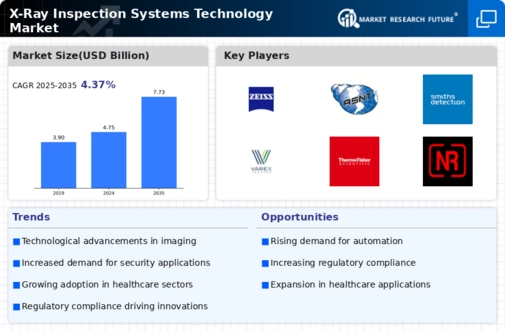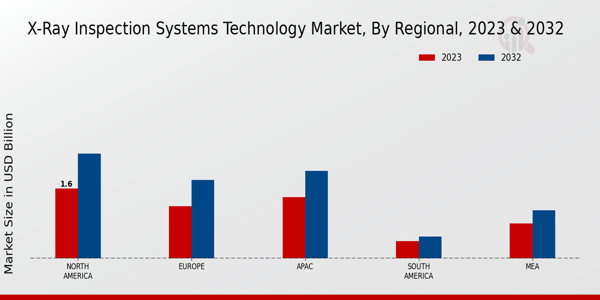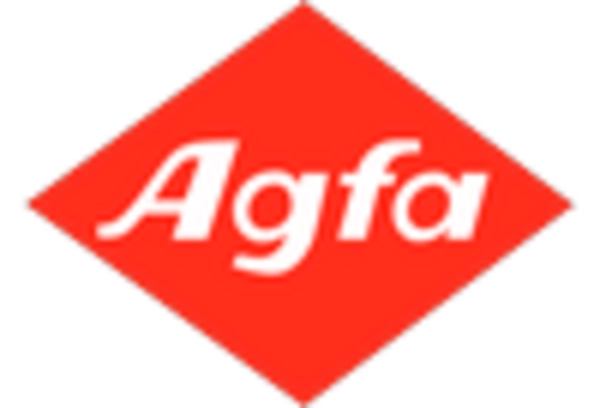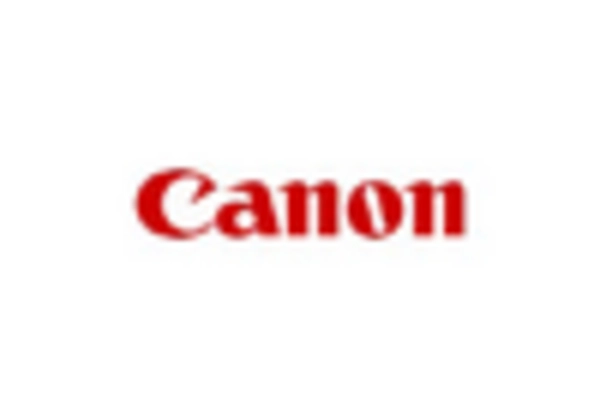-
EXECUTIVE SUMMARY
-
Market Overview
-
Key Findings
-
Market Segmentation
-
Competitive Landscape
-
Challenges and Opportunities
-
Future Outlook
-
MARKET INTRODUCTION
-
Definition
-
Scope of the study
- Research Objective
- Assumption
- Limitations
-
RESEARCH METHODOLOGY
-
Overview
-
Data Mining
-
Secondary Research
-
Primary Research
- Primary Interviews and Information Gathering Process
- Breakdown of Primary Respondents
-
Forecasting Model
-
Market Size Estimation
- Bottom-Up Approach
- Top-Down Approach
-
Data Triangulation
-
Validation
-
MARKET DYNAMICS
-
Overview
-
Drivers
-
Restraints
-
Opportunities
-
MARKET FACTOR ANALYSIS
-
Value chain Analysis
-
Porter's Five Forces Analysis
- Bargaining Power of Suppliers
- Bargaining Power of Buyers
- Threat of New Entrants
- Threat of Substitutes
- Intensity of Rivalry
-
COVID-19 Impact Analysis
- Market Impact Analysis
- Regional Impact
- Opportunity and Threat Analysis
-
X-RAY INSPECTION SYSTEMS TECHNOLOGY MARKET, BY APPLICATION (USD BILLION)
-
Quality Control
-
Security Inspection
-
Nondestructive Testing
-
Industrial Inspection
-
X-RAY INSPECTION SYSTEMS TECHNOLOGY MARKET, BY TECHNOLOGY (USD BILLION)
-
Computed Tomography
-
Digital Radiography
-
Radiographic Testing
-
X-RAY INSPECTION SYSTEMS TECHNOLOGY MARKET, BY END USE INDUSTRY (USD BILLION)
-
Aerospace
-
Automotive
-
Healthcare
-
Manufacturing
-
Food and Beverage
-
X-RAY INSPECTION SYSTEMS TECHNOLOGY MARKET, BY COMPONENT (USD BILLION)
-
X-Ray Source
-
Detector
-
X-Ray System Software
-
Accessories
-
X-RAY INSPECTION SYSTEMS TECHNOLOGY MARKET, BY REGIONAL (USD BILLION)
-
North America
- US
- Canada
-
Europe
- Germany
- UK
- France
- Russia
- Italy
- Spain
- Rest of Europe
-
APAC
- China
- India
- Japan
- South Korea
- Malaysia
- Thailand
- Indonesia
- Rest of APAC
-
South America
- Brazil
- Mexico
- Argentina
- Rest of South America
-
MEA
- GCC Countries
- South Africa
- Rest of MEA
-
COMPETITIVE LANDSCAPE
-
Overview
-
Competitive Analysis
-
Market share Analysis
-
Major Growth Strategy in the X-Ray Inspection Systems Technology Market
-
Competitive Benchmarking
-
Leading Players in Terms of Number of Developments in the X-Ray Inspection Systems Technology Market
-
Key developments and growth strategies
- New Product Launch/Service Deployment
- Merger & Acquisitions
- Joint Ventures
-
Major Players Financial Matrix
- Sales and Operating Income
- Major Players R&D Expenditure. 2023
-
COMPANY PROFILES
-
Zeiss
- Financial Overview
- Products Offered
- Key Developments
- SWOT Analysis
- Key Strategies
-
Shimadzu Corporation
- Financial Overview
- Products Offered
- Key Developments
- SWOT Analysis
- Key Strategies
-
ASNT
- Financial Overview
- Products Offered
- Key Developments
- SWOT Analysis
- Key Strategies
-
GE Healthcare
- Financial Overview
- Products Offered
- Key Developments
- SWOT Analysis
- Key Strategies
-
Cognex Corporation
- Financial Overview
- Products Offered
- Key Developments
- SWOT Analysis
- Key Strategies
-
Smiths Detection
- Financial Overview
- Products Offered
- Key Developments
- SWOT Analysis
- Key Strategies
-
Varex Imaging
- Financial Overview
- Products Offered
- Key Developments
- SWOT Analysis
- Key Strategies
-
Kromek Group
- Financial Overview
- Products Offered
- Key Developments
- SWOT Analysis
- Key Strategies
-
Thermo Fisher Scientific
- Financial Overview
- Products Offered
- Key Developments
- SWOT Analysis
- Key Strategies
-
Analogic Corporation
- Financial Overview
- Products Offered
- Key Developments
- SWOT Analysis
- Key Strategies
-
Hitachi HighTechnologies
- Financial Overview
- Products Offered
- Key Developments
- SWOT Analysis
- Key Strategies
-
Xcerra Corporation
- Financial Overview
- Products Offered
- Key Developments
- SWOT Analysis
- Key Strategies
-
Nikon
- Financial Overview
- Products Offered
- Key Developments
- SWOT Analysis
- Key Strategies
-
Danaher Corporation
- Financial Overview
- Products Offered
- Key Developments
- SWOT Analysis
- Key Strategies
-
Mettler Toledo
- Financial Overview
- Products Offered
- Key Developments
- SWOT Analysis
- Key Strategies
-
APPENDIX
-
References
-
Related Reports\r\n
-
LIST OF TABLES
-
LIST OF ASSUMPTIONS
-
NORTH AMERICA X-RAY INSPECTION SYSTEMS TECHNOLOGY MARKET SIZE ESTIMATES & FORECAST, BY APPLICATION, 2019-2032 (USD BILLIONS)
-
NORTH AMERICA X-RAY INSPECTION SYSTEMS TECHNOLOGY MARKET SIZE ESTIMATES & FORECAST, BY TECHNOLOGY, 2019-2032 (USD BILLIONS)
-
NORTH AMERICA X-RAY INSPECTION SYSTEMS TECHNOLOGY MARKET SIZE ESTIMATES & FORECAST, BY END USE INDUSTRY, 2019-2032 (USD BILLIONS)
-
NORTH AMERICA X-RAY INSPECTION SYSTEMS TECHNOLOGY MARKET SIZE ESTIMATES & FORECAST, BY COMPONENT, 2019-2032 (USD BILLIONS)
-
NORTH AMERICA X-RAY INSPECTION SYSTEMS TECHNOLOGY MARKET SIZE ESTIMATES & FORECAST, BY REGIONAL, 2019-2032 (USD BILLIONS)
-
US X-RAY INSPECTION SYSTEMS TECHNOLOGY MARKET SIZE ESTIMATES & FORECAST, BY APPLICATION, 2019-2032 (USD BILLIONS)
-
US X-RAY INSPECTION SYSTEMS TECHNOLOGY MARKET SIZE ESTIMATES & FORECAST, BY TECHNOLOGY, 2019-2032 (USD BILLIONS)
-
US X-RAY INSPECTION SYSTEMS TECHNOLOGY MARKET SIZE ESTIMATES & FORECAST, BY END USE INDUSTRY, 2019-2032 (USD BILLIONS)
-
US X-RAY INSPECTION SYSTEMS TECHNOLOGY MARKET SIZE ESTIMATES & FORECAST, BY COMPONENT, 2019-2032 (USD BILLIONS)
-
US X-RAY INSPECTION SYSTEMS TECHNOLOGY MARKET SIZE ESTIMATES & FORECAST, BY REGIONAL, 2019-2032 (USD BILLIONS)
-
CANADA X-RAY INSPECTION SYSTEMS TECHNOLOGY MARKET SIZE ESTIMATES & FORECAST, BY APPLICATION, 2019-2032 (USD BILLIONS)
-
CANADA X-RAY INSPECTION SYSTEMS TECHNOLOGY MARKET SIZE ESTIMATES & FORECAST, BY TECHNOLOGY, 2019-2032 (USD BILLIONS)
-
CANADA X-RAY INSPECTION SYSTEMS TECHNOLOGY MARKET SIZE ESTIMATES & FORECAST, BY END USE INDUSTRY, 2019-2032 (USD BILLIONS)
-
CANADA X-RAY INSPECTION SYSTEMS TECHNOLOGY MARKET SIZE ESTIMATES & FORECAST, BY COMPONENT, 2019-2032 (USD BILLIONS)
-
CANADA X-RAY INSPECTION SYSTEMS TECHNOLOGY MARKET SIZE ESTIMATES & FORECAST, BY REGIONAL, 2019-2032 (USD BILLIONS)
-
EUROPE X-RAY INSPECTION SYSTEMS TECHNOLOGY MARKET SIZE ESTIMATES & FORECAST, BY APPLICATION, 2019-2032 (USD BILLIONS)
-
EUROPE X-RAY INSPECTION SYSTEMS TECHNOLOGY MARKET SIZE ESTIMATES & FORECAST, BY TECHNOLOGY, 2019-2032 (USD BILLIONS)
-
EUROPE X-RAY INSPECTION SYSTEMS TECHNOLOGY MARKET SIZE ESTIMATES & FORECAST, BY END USE INDUSTRY, 2019-2032 (USD BILLIONS)
-
EUROPE X-RAY INSPECTION SYSTEMS TECHNOLOGY MARKET SIZE ESTIMATES & FORECAST, BY COMPONENT, 2019-2032 (USD BILLIONS)
-
EUROPE X-RAY INSPECTION SYSTEMS TECHNOLOGY MARKET SIZE ESTIMATES & FORECAST, BY REGIONAL, 2019-2032 (USD BILLIONS)
-
GERMANY X-RAY INSPECTION SYSTEMS TECHNOLOGY MARKET SIZE ESTIMATES & FORECAST, BY APPLICATION, 2019-2032 (USD BILLIONS)
-
GERMANY X-RAY INSPECTION SYSTEMS TECHNOLOGY MARKET SIZE ESTIMATES & FORECAST, BY TECHNOLOGY, 2019-2032 (USD BILLIONS)
-
GERMANY X-RAY INSPECTION SYSTEMS TECHNOLOGY MARKET SIZE ESTIMATES & FORECAST, BY END USE INDUSTRY, 2019-2032 (USD BILLIONS)
-
GERMANY X-RAY INSPECTION SYSTEMS TECHNOLOGY MARKET SIZE ESTIMATES & FORECAST, BY COMPONENT, 2019-2032 (USD BILLIONS)
-
GERMANY X-RAY INSPECTION SYSTEMS TECHNOLOGY MARKET SIZE ESTIMATES & FORECAST, BY REGIONAL, 2019-2032 (USD BILLIONS)
-
UK X-RAY INSPECTION SYSTEMS TECHNOLOGY MARKET SIZE ESTIMATES & FORECAST, BY APPLICATION, 2019-2032 (USD BILLIONS)
-
UK X-RAY INSPECTION SYSTEMS TECHNOLOGY MARKET SIZE ESTIMATES & FORECAST, BY TECHNOLOGY, 2019-2032 (USD BILLIONS)
-
UK X-RAY INSPECTION SYSTEMS TECHNOLOGY MARKET SIZE ESTIMATES & FORECAST, BY END USE INDUSTRY, 2019-2032 (USD BILLIONS)
-
UK X-RAY INSPECTION SYSTEMS TECHNOLOGY MARKET SIZE ESTIMATES & FORECAST, BY COMPONENT, 2019-2032 (USD BILLIONS)
-
UK X-RAY INSPECTION SYSTEMS TECHNOLOGY MARKET SIZE ESTIMATES & FORECAST, BY REGIONAL, 2019-2032 (USD BILLIONS)
-
FRANCE X-RAY INSPECTION SYSTEMS TECHNOLOGY MARKET SIZE ESTIMATES & FORECAST, BY APPLICATION, 2019-2032 (USD BILLIONS)
-
FRANCE X-RAY INSPECTION SYSTEMS TECHNOLOGY MARKET SIZE ESTIMATES & FORECAST, BY TECHNOLOGY, 2019-2032 (USD BILLIONS)
-
FRANCE X-RAY INSPECTION SYSTEMS TECHNOLOGY MARKET SIZE ESTIMATES & FORECAST, BY END USE INDUSTRY, 2019-2032 (USD BILLIONS)
-
FRANCE X-RAY INSPECTION SYSTEMS TECHNOLOGY MARKET SIZE ESTIMATES & FORECAST, BY COMPONENT, 2019-2032 (USD BILLIONS)
-
FRANCE X-RAY INSPECTION SYSTEMS TECHNOLOGY MARKET SIZE ESTIMATES & FORECAST, BY REGIONAL, 2019-2032 (USD BILLIONS)
-
RUSSIA X-RAY INSPECTION SYSTEMS TECHNOLOGY MARKET SIZE ESTIMATES & FORECAST, BY APPLICATION, 2019-2032 (USD BILLIONS)
-
RUSSIA X-RAY INSPECTION SYSTEMS TECHNOLOGY MARKET SIZE ESTIMATES & FORECAST, BY TECHNOLOGY, 2019-2032 (USD BILLIONS)
-
RUSSIA X-RAY INSPECTION SYSTEMS TECHNOLOGY MARKET SIZE ESTIMATES & FORECAST, BY END USE INDUSTRY, 2019-2032 (USD BILLIONS)
-
RUSSIA X-RAY INSPECTION SYSTEMS TECHNOLOGY MARKET SIZE ESTIMATES & FORECAST, BY COMPONENT, 2019-2032 (USD BILLIONS)
-
RUSSIA X-RAY INSPECTION SYSTEMS TECHNOLOGY MARKET SIZE ESTIMATES & FORECAST, BY REGIONAL, 2019-2032 (USD BILLIONS)
-
ITALY X-RAY INSPECTION SYSTEMS TECHNOLOGY MARKET SIZE ESTIMATES & FORECAST, BY APPLICATION, 2019-2032 (USD BILLIONS)
-
ITALY X-RAY INSPECTION SYSTEMS TECHNOLOGY MARKET SIZE ESTIMATES & FORECAST, BY TECHNOLOGY, 2019-2032 (USD BILLIONS)
-
ITALY X-RAY INSPECTION SYSTEMS TECHNOLOGY MARKET SIZE ESTIMATES & FORECAST, BY END USE INDUSTRY, 2019-2032 (USD BILLIONS)
-
ITALY X-RAY INSPECTION SYSTEMS TECHNOLOGY MARKET SIZE ESTIMATES & FORECAST, BY COMPONENT, 2019-2032 (USD BILLIONS)
-
ITALY X-RAY INSPECTION SYSTEMS TECHNOLOGY MARKET SIZE ESTIMATES & FORECAST, BY REGIONAL, 2019-2032 (USD BILLIONS)
-
SPAIN X-RAY INSPECTION SYSTEMS TECHNOLOGY MARKET SIZE ESTIMATES & FORECAST, BY APPLICATION, 2019-2032 (USD BILLIONS)
-
SPAIN X-RAY INSPECTION SYSTEMS TECHNOLOGY MARKET SIZE ESTIMATES & FORECAST, BY TECHNOLOGY, 2019-2032 (USD BILLIONS)
-
SPAIN X-RAY INSPECTION SYSTEMS TECHNOLOGY MARKET SIZE ESTIMATES & FORECAST, BY END USE INDUSTRY, 2019-2032 (USD BILLIONS)
-
SPAIN X-RAY INSPECTION SYSTEMS TECHNOLOGY MARKET SIZE ESTIMATES & FORECAST, BY COMPONENT, 2019-2032 (USD BILLIONS)
-
SPAIN X-RAY INSPECTION SYSTEMS TECHNOLOGY MARKET SIZE ESTIMATES & FORECAST, BY REGIONAL, 2019-2032 (USD BILLIONS)
-
REST OF EUROPE X-RAY INSPECTION SYSTEMS TECHNOLOGY MARKET SIZE ESTIMATES & FORECAST, BY APPLICATION, 2019-2032 (USD BILLIONS)
-
REST OF EUROPE X-RAY INSPECTION SYSTEMS TECHNOLOGY MARKET SIZE ESTIMATES & FORECAST, BY TECHNOLOGY, 2019-2032 (USD BILLIONS)
-
REST OF EUROPE X-RAY INSPECTION SYSTEMS TECHNOLOGY MARKET SIZE ESTIMATES & FORECAST, BY END USE INDUSTRY, 2019-2032 (USD BILLIONS)
-
REST OF EUROPE X-RAY INSPECTION SYSTEMS TECHNOLOGY MARKET SIZE ESTIMATES & FORECAST, BY COMPONENT, 2019-2032 (USD BILLIONS)
-
REST OF EUROPE X-RAY INSPECTION SYSTEMS TECHNOLOGY MARKET SIZE ESTIMATES & FORECAST, BY REGIONAL, 2019-2032 (USD BILLIONS)
-
APAC X-RAY INSPECTION SYSTEMS TECHNOLOGY MARKET SIZE ESTIMATES & FORECAST, BY APPLICATION, 2019-2032 (USD BILLIONS)
-
APAC X-RAY INSPECTION SYSTEMS TECHNOLOGY MARKET SIZE ESTIMATES & FORECAST, BY TECHNOLOGY, 2019-2032 (USD BILLIONS)
-
APAC X-RAY INSPECTION SYSTEMS TECHNOLOGY MARKET SIZE ESTIMATES & FORECAST, BY END USE INDUSTRY, 2019-2032 (USD BILLIONS)
-
APAC X-RAY INSPECTION SYSTEMS TECHNOLOGY MARKET SIZE ESTIMATES & FORECAST, BY COMPONENT, 2019-2032 (USD BILLIONS)
-
APAC X-RAY INSPECTION SYSTEMS TECHNOLOGY MARKET SIZE ESTIMATES & FORECAST, BY REGIONAL, 2019-2032 (USD BILLIONS)
-
CHINA X-RAY INSPECTION SYSTEMS TECHNOLOGY MARKET SIZE ESTIMATES & FORECAST, BY APPLICATION, 2019-2032 (USD BILLIONS)
-
CHINA X-RAY INSPECTION SYSTEMS TECHNOLOGY MARKET SIZE ESTIMATES & FORECAST, BY TECHNOLOGY, 2019-2032 (USD BILLIONS)
-
CHINA X-RAY INSPECTION SYSTEMS TECHNOLOGY MARKET SIZE ESTIMATES & FORECAST, BY END USE INDUSTRY, 2019-2032 (USD BILLIONS)
-
CHINA X-RAY INSPECTION SYSTEMS TECHNOLOGY MARKET SIZE ESTIMATES & FORECAST, BY COMPONENT, 2019-2032 (USD BILLIONS)
-
CHINA X-RAY INSPECTION SYSTEMS TECHNOLOGY MARKET SIZE ESTIMATES & FORECAST, BY REGIONAL, 2019-2032 (USD BILLIONS)
-
INDIA X-RAY INSPECTION SYSTEMS TECHNOLOGY MARKET SIZE ESTIMATES & FORECAST, BY APPLICATION, 2019-2032 (USD BILLIONS)
-
INDIA X-RAY INSPECTION SYSTEMS TECHNOLOGY MARKET SIZE ESTIMATES & FORECAST, BY TECHNOLOGY, 2019-2032 (USD BILLIONS)
-
INDIA X-RAY INSPECTION SYSTEMS TECHNOLOGY MARKET SIZE ESTIMATES & FORECAST, BY END USE INDUSTRY, 2019-2032 (USD BILLIONS)
-
INDIA X-RAY INSPECTION SYSTEMS TECHNOLOGY MARKET SIZE ESTIMATES & FORECAST, BY COMPONENT, 2019-2032 (USD BILLIONS)
-
INDIA X-RAY INSPECTION SYSTEMS TECHNOLOGY MARKET SIZE ESTIMATES & FORECAST, BY REGIONAL, 2019-2032 (USD BILLIONS)
-
JAPAN X-RAY INSPECTION SYSTEMS TECHNOLOGY MARKET SIZE ESTIMATES & FORECAST, BY APPLICATION, 2019-2032 (USD BILLIONS)
-
JAPAN X-RAY INSPECTION SYSTEMS TECHNOLOGY MARKET SIZE ESTIMATES & FORECAST, BY TECHNOLOGY, 2019-2032 (USD BILLIONS)
-
JAPAN X-RAY INSPECTION SYSTEMS TECHNOLOGY MARKET SIZE ESTIMATES & FORECAST, BY END USE INDUSTRY, 2019-2032 (USD BILLIONS)
-
JAPAN X-RAY INSPECTION SYSTEMS TECHNOLOGY MARKET SIZE ESTIMATES & FORECAST, BY COMPONENT, 2019-2032 (USD BILLIONS)
-
JAPAN X-RAY INSPECTION SYSTEMS TECHNOLOGY MARKET SIZE ESTIMATES & FORECAST, BY REGIONAL, 2019-2032 (USD BILLIONS)
-
SOUTH KOREA X-RAY INSPECTION SYSTEMS TECHNOLOGY MARKET SIZE ESTIMATES & FORECAST, BY APPLICATION, 2019-2032 (USD BILLIONS)
-
SOUTH KOREA X-RAY INSPECTION SYSTEMS TECHNOLOGY MARKET SIZE ESTIMATES & FORECAST, BY TECHNOLOGY, 2019-2032 (USD BILLIONS)
-
SOUTH KOREA X-RAY INSPECTION SYSTEMS TECHNOLOGY MARKET SIZE ESTIMATES & FORECAST, BY END USE INDUSTRY, 2019-2032 (USD BILLIONS)
-
SOUTH KOREA X-RAY INSPECTION SYSTEMS TECHNOLOGY MARKET SIZE ESTIMATES & FORECAST, BY COMPONENT, 2019-2032 (USD BILLIONS)
-
SOUTH KOREA X-RAY INSPECTION SYSTEMS TECHNOLOGY MARKET SIZE ESTIMATES & FORECAST, BY REGIONAL, 2019-2032 (USD BILLIONS)
-
MALAYSIA X-RAY INSPECTION SYSTEMS TECHNOLOGY MARKET SIZE ESTIMATES & FORECAST, BY APPLICATION, 2019-2032 (USD BILLIONS)
-
MALAYSIA X-RAY INSPECTION SYSTEMS TECHNOLOGY MARKET SIZE ESTIMATES & FORECAST, BY TECHNOLOGY, 2019-2032 (USD BILLIONS)
-
MALAYSIA X-RAY INSPECTION SYSTEMS TECHNOLOGY MARKET SIZE ESTIMATES & FORECAST, BY END USE INDUSTRY, 2019-2032 (USD BILLIONS)
-
MALAYSIA X-RAY INSPECTION SYSTEMS TECHNOLOGY MARKET SIZE ESTIMATES & FORECAST, BY COMPONENT, 2019-2032 (USD BILLIONS)
-
MALAYSIA X-RAY INSPECTION SYSTEMS TECHNOLOGY MARKET SIZE ESTIMATES & FORECAST, BY REGIONAL, 2019-2032 (USD BILLIONS)
-
THAILAND X-RAY INSPECTION SYSTEMS TECHNOLOGY MARKET SIZE ESTIMATES & FORECAST, BY APPLICATION, 2019-2032 (USD BILLIONS)
-
THAILAND X-RAY INSPECTION SYSTEMS TECHNOLOGY MARKET SIZE ESTIMATES & FORECAST, BY TECHNOLOGY, 2019-2032 (USD BILLIONS)
-
THAILAND X-RAY INSPECTION SYSTEMS TECHNOLOGY MARKET SIZE ESTIMATES & FORECAST, BY END USE INDUSTRY, 2019-2032 (USD BILLIONS)
-
THAILAND X-RAY INSPECTION SYSTEMS TECHNOLOGY MARKET SIZE ESTIMATES & FORECAST, BY COMPONENT, 2019-2032 (USD BILLIONS)
-
THAILAND X-RAY INSPECTION SYSTEMS TECHNOLOGY MARKET SIZE ESTIMATES & FORECAST, BY REGIONAL, 2019-2032 (USD BILLIONS)
-
INDONESIA X-RAY INSPECTION SYSTEMS TECHNOLOGY MARKET SIZE ESTIMATES & FORECAST, BY APPLICATION, 2019-2032 (USD BILLIONS)
-
INDONESIA X-RAY INSPECTION SYSTEMS TECHNOLOGY MARKET SIZE ESTIMATES & FORECAST, BY TECHNOLOGY, 2019-2032 (USD BILLIONS)
-
INDONESIA X-RAY INSPECTION SYSTEMS TECHNOLOGY MARKET SIZE ESTIMATES & FORECAST, BY END USE INDUSTRY, 2019-2032 (USD BILLIONS)
-
INDONESIA X-RAY INSPECTION SYSTEMS TECHNOLOGY MARKET SIZE ESTIMATES & FORECAST, BY COMPONENT, 2019-2032 (USD BILLIONS)
-
INDONESIA X-RAY INSPECTION SYSTEMS TECHNOLOGY MARKET SIZE ESTIMATES & FORECAST, BY REGIONAL, 2019-2032 (USD BILLIONS)
-
REST OF APAC X-RAY INSPECTION SYSTEMS TECHNOLOGY MARKET SIZE ESTIMATES & FORECAST, BY APPLICATION, 2019-2032 (USD BILLIONS)
-
REST OF APAC X-RAY INSPECTION SYSTEMS TECHNOLOGY MARKET SIZE ESTIMATES & FORECAST, BY TECHNOLOGY, 2019-2032 (USD BILLIONS)
-
REST OF APAC X-RAY INSPECTION SYSTEMS TECHNOLOGY MARKET SIZE ESTIMATES & FORECAST, BY END USE INDUSTRY, 2019-2032 (USD BILLIONS)
-
REST OF APAC X-RAY INSPECTION SYSTEMS TECHNOLOGY MARKET SIZE ESTIMATES & FORECAST, BY COMPONENT, 2019-2032 (USD BILLIONS)
-
REST OF APAC X-RAY INSPECTION SYSTEMS TECHNOLOGY MARKET SIZE ESTIMATES & FORECAST, BY REGIONAL, 2019-2032 (USD BILLIONS)
-
SOUTH AMERICA X-RAY INSPECTION SYSTEMS TECHNOLOGY MARKET SIZE ESTIMATES & FORECAST, BY APPLICATION, 2019-2032 (USD BILLIONS)
-
SOUTH AMERICA X-RAY INSPECTION SYSTEMS TECHNOLOGY MARKET SIZE ESTIMATES & FORECAST, BY TECHNOLOGY, 2019-2032 (USD BILLIONS)
-
SOUTH AMERICA X-RAY INSPECTION SYSTEMS TECHNOLOGY MARKET SIZE ESTIMATES & FORECAST, BY END USE INDUSTRY, 2019-2032 (USD BILLIONS)
-
SOUTH AMERICA X-RAY INSPECTION SYSTEMS TECHNOLOGY MARKET SIZE ESTIMATES & FORECAST, BY COMPONENT, 2019-2032 (USD BILLIONS)
-
SOUTH AMERICA X-RAY INSPECTION SYSTEMS TECHNOLOGY MARKET SIZE ESTIMATES & FORECAST, BY REGIONAL, 2019-2032 (USD BILLIONS)
-
BRAZIL X-RAY INSPECTION SYSTEMS TECHNOLOGY MARKET SIZE ESTIMATES & FORECAST, BY APPLICATION, 2019-2032 (USD BILLIONS)
-
BRAZIL X-RAY INSPECTION SYSTEMS TECHNOLOGY MARKET SIZE ESTIMATES & FORECAST, BY TECHNOLOGY, 2019-2032 (USD BILLIONS)
-
BRAZIL X-RAY INSPECTION SYSTEMS TECHNOLOGY MARKET SIZE ESTIMATES & FORECAST, BY END USE INDUSTRY, 2019-2032 (USD BILLIONS)
-
BRAZIL X-RAY INSPECTION SYSTEMS TECHNOLOGY MARKET SIZE ESTIMATES & FORECAST, BY COMPONENT, 2019-2032 (USD BILLIONS)
-
BRAZIL X-RAY INSPECTION SYSTEMS TECHNOLOGY MARKET SIZE ESTIMATES & FORECAST, BY REGIONAL, 2019-2032 (USD BILLIONS)
-
MEXICO X-RAY INSPECTION SYSTEMS TECHNOLOGY MARKET SIZE ESTIMATES & FORECAST, BY APPLICATION, 2019-2032 (USD BILLIONS)
-
MEXICO X-RAY INSPECTION SYSTEMS TECHNOLOGY MARKET SIZE ESTIMATES & FORECAST, BY TECHNOLOGY, 2019-2032 (USD BILLIONS)
-
MEXICO X-RAY INSPECTION SYSTEMS TECHNOLOGY MARKET SIZE ESTIMATES & FORECAST, BY END USE INDUSTRY, 2019-2032 (USD BILLIONS)
-
MEXICO X-RAY INSPECTION SYSTEMS TECHNOLOGY MARKET SIZE ESTIMATES & FORECAST, BY COMPONENT, 2019-2032 (USD BILLIONS)
-
MEXICO X-RAY INSPECTION SYSTEMS TECHNOLOGY MARKET SIZE ESTIMATES & FORECAST, BY REGIONAL, 2019-2032 (USD BILLIONS)
-
ARGENTINA X-RAY INSPECTION SYSTEMS TECHNOLOGY MARKET SIZE ESTIMATES & FORECAST, BY APPLICATION, 2019-2032 (USD BILLIONS)
-
ARGENTINA X-RAY INSPECTION SYSTEMS TECHNOLOGY MARKET SIZE ESTIMATES & FORECAST, BY TECHNOLOGY, 2019-2032 (USD BILLIONS)
-
ARGENTINA X-RAY INSPECTION SYSTEMS TECHNOLOGY MARKET SIZE ESTIMATES & FORECAST, BY END USE INDUSTRY, 2019-2032 (USD BILLIONS)
-
ARGENTINA X-RAY INSPECTION SYSTEMS TECHNOLOGY MARKET SIZE ESTIMATES & FORECAST, BY COMPONENT, 2019-2032 (USD BILLIONS)
-
ARGENTINA X-RAY INSPECTION SYSTEMS TECHNOLOGY MARKET SIZE ESTIMATES & FORECAST, BY REGIONAL, 2019-2032 (USD BILLIONS)
-
REST OF SOUTH AMERICA X-RAY INSPECTION SYSTEMS TECHNOLOGY MARKET SIZE ESTIMATES & FORECAST, BY APPLICATION, 2019-2032 (USD BILLIONS)
-
REST OF SOUTH AMERICA X-RAY INSPECTION SYSTEMS TECHNOLOGY MARKET SIZE ESTIMATES & FORECAST, BY TECHNOLOGY, 2019-2032 (USD BILLIONS)
-
REST OF SOUTH AMERICA X-RAY INSPECTION SYSTEMS TECHNOLOGY MARKET SIZE ESTIMATES & FORECAST, BY END USE INDUSTRY, 2019-2032 (USD BILLIONS)
-
REST OF SOUTH AMERICA X-RAY INSPECTION SYSTEMS TECHNOLOGY MARKET SIZE ESTIMATES & FORECAST, BY COMPONENT, 2019-2032 (USD BILLIONS)
-
REST OF SOUTH AMERICA X-RAY INSPECTION SYSTEMS TECHNOLOGY MARKET SIZE ESTIMATES & FORECAST, BY REGIONAL, 2019-2032 (USD BILLIONS)
-
MEA X-RAY INSPECTION SYSTEMS TECHNOLOGY MARKET SIZE ESTIMATES & FORECAST, BY APPLICATION, 2019-2032 (USD BILLIONS)
-
MEA X-RAY INSPECTION SYSTEMS TECHNOLOGY MARKET SIZE ESTIMATES & FORECAST, BY TECHNOLOGY, 2019-2032 (USD BILLIONS)
-
MEA X-RAY INSPECTION SYSTEMS TECHNOLOGY MARKET SIZE ESTIMATES & FORECAST, BY END USE INDUSTRY, 2019-2032 (USD BILLIONS)
-
MEA X-RAY INSPECTION SYSTEMS TECHNOLOGY MARKET SIZE ESTIMATES & FORECAST, BY COMPONENT, 2019-2032 (USD BILLIONS)
-
MEA X-RAY INSPECTION SYSTEMS TECHNOLOGY MARKET SIZE ESTIMATES & FORECAST, BY REGIONAL, 2019-2032 (USD BILLIONS)
-
GCC COUNTRIES X-RAY INSPECTION SYSTEMS TECHNOLOGY MARKET SIZE ESTIMATES & FORECAST, BY APPLICATION, 2019-2032 (USD BILLIONS)
-
GCC COUNTRIES X-RAY INSPECTION SYSTEMS TECHNOLOGY MARKET SIZE ESTIMATES & FORECAST, BY TECHNOLOGY, 2019-2032 (USD BILLIONS)
-
GCC COUNTRIES X-RAY INSPECTION SYSTEMS TECHNOLOGY MARKET SIZE ESTIMATES & FORECAST, BY END USE INDUSTRY, 2019-2032 (USD BILLIONS)
-
GCC COUNTRIES X-RAY INSPECTION SYSTEMS TECHNOLOGY MARKET SIZE ESTIMATES & FORECAST, BY COMPONENT, 2019-2032 (USD BILLIONS)
-
GCC COUNTRIES X-RAY INSPECTION SYSTEMS TECHNOLOGY MARKET SIZE ESTIMATES & FORECAST, BY REGIONAL, 2019-2032 (USD BILLIONS)
-
SOUTH AFRICA X-RAY INSPECTION SYSTEMS TECHNOLOGY MARKET SIZE ESTIMATES & FORECAST, BY APPLICATION, 2019-2032 (USD BILLIONS)
-
SOUTH AFRICA X-RAY INSPECTION SYSTEMS TECHNOLOGY MARKET SIZE ESTIMATES & FORECAST, BY TECHNOLOGY, 2019-2032 (USD BILLIONS)
-
SOUTH AFRICA X-RAY INSPECTION SYSTEMS TECHNOLOGY MARKET SIZE ESTIMATES & FORECAST, BY END USE INDUSTRY, 2019-2032 (USD BILLIONS)
-
SOUTH AFRICA X-RAY INSPECTION SYSTEMS TECHNOLOGY MARKET SIZE ESTIMATES & FORECAST, BY COMPONENT, 2019-2032 (USD BILLIONS)
-
SOUTH AFRICA X-RAY INSPECTION SYSTEMS TECHNOLOGY MARKET SIZE ESTIMATES & FORECAST, BY REGIONAL, 2019-2032 (USD BILLIONS)
-
REST OF MEA X-RAY INSPECTION SYSTEMS TECHNOLOGY MARKET SIZE ESTIMATES & FORECAST, BY APPLICATION, 2019-2032 (USD BILLIONS)
-
REST OF MEA X-RAY INSPECTION SYSTEMS TECHNOLOGY MARKET SIZE ESTIMATES & FORECAST, BY TECHNOLOGY, 2019-2032 (USD BILLIONS)
-
REST OF MEA X-RAY INSPECTION SYSTEMS TECHNOLOGY MARKET SIZE ESTIMATES & FORECAST, BY END USE INDUSTRY, 2019-2032 (USD BILLIONS)
-
REST OF MEA X-RAY INSPECTION SYSTEMS TECHNOLOGY MARKET SIZE ESTIMATES & FORECAST, BY COMPONENT, 2019-2032 (USD BILLIONS)
-
REST OF MEA X-RAY INSPECTION SYSTEMS TECHNOLOGY MARKET SIZE ESTIMATES & FORECAST, BY REGIONAL, 2019-2032 (USD BILLIONS)
-
PRODUCT LAUNCH/PRODUCT DEVELOPMENT/APPROVAL
-
ACQUISITION/PARTNERSHIP
-
LIST OF FIGURES
-
MARKET SYNOPSIS
-
NORTH AMERICA X-RAY INSPECTION SYSTEMS TECHNOLOGY MARKET ANALYSIS
-
US X-RAY INSPECTION SYSTEMS TECHNOLOGY MARKET ANALYSIS BY APPLICATION
-
US X-RAY INSPECTION SYSTEMS TECHNOLOGY MARKET ANALYSIS BY TECHNOLOGY
-
US X-RAY INSPECTION SYSTEMS TECHNOLOGY MARKET ANALYSIS BY END USE INDUSTRY
-
US X-RAY INSPECTION SYSTEMS TECHNOLOGY MARKET ANALYSIS BY COMPONENT
-
US X-RAY INSPECTION SYSTEMS TECHNOLOGY MARKET ANALYSIS BY REGIONAL
-
CANADA X-RAY INSPECTION SYSTEMS TECHNOLOGY MARKET ANALYSIS BY APPLICATION
-
CANADA X-RAY INSPECTION SYSTEMS TECHNOLOGY MARKET ANALYSIS BY TECHNOLOGY
-
CANADA X-RAY INSPECTION SYSTEMS TECHNOLOGY MARKET ANALYSIS BY END USE INDUSTRY
-
CANADA X-RAY INSPECTION SYSTEMS TECHNOLOGY MARKET ANALYSIS BY COMPONENT
-
CANADA X-RAY INSPECTION SYSTEMS TECHNOLOGY MARKET ANALYSIS BY REGIONAL
-
EUROPE X-RAY INSPECTION SYSTEMS TECHNOLOGY MARKET ANALYSIS
-
GERMANY X-RAY INSPECTION SYSTEMS TECHNOLOGY MARKET ANALYSIS BY APPLICATION
-
GERMANY X-RAY INSPECTION SYSTEMS TECHNOLOGY MARKET ANALYSIS BY TECHNOLOGY
-
GERMANY X-RAY INSPECTION SYSTEMS TECHNOLOGY MARKET ANALYSIS BY END USE INDUSTRY
-
GERMANY X-RAY INSPECTION SYSTEMS TECHNOLOGY MARKET ANALYSIS BY COMPONENT
-
GERMANY X-RAY INSPECTION SYSTEMS TECHNOLOGY MARKET ANALYSIS BY REGIONAL
-
UK X-RAY INSPECTION SYSTEMS TECHNOLOGY MARKET ANALYSIS BY APPLICATION
-
UK X-RAY INSPECTION SYSTEMS TECHNOLOGY MARKET ANALYSIS BY TECHNOLOGY
-
UK X-RAY INSPECTION SYSTEMS TECHNOLOGY MARKET ANALYSIS BY END USE INDUSTRY
-
UK X-RAY INSPECTION SYSTEMS TECHNOLOGY MARKET ANALYSIS BY COMPONENT
-
UK X-RAY INSPECTION SYSTEMS TECHNOLOGY MARKET ANALYSIS BY REGIONAL
-
FRANCE X-RAY INSPECTION SYSTEMS TECHNOLOGY MARKET ANALYSIS BY APPLICATION
-
FRANCE X-RAY INSPECTION SYSTEMS TECHNOLOGY MARKET ANALYSIS BY TECHNOLOGY
-
FRANCE X-RAY INSPECTION SYSTEMS TECHNOLOGY MARKET ANALYSIS BY END USE INDUSTRY
-
FRANCE X-RAY INSPECTION SYSTEMS TECHNOLOGY MARKET ANALYSIS BY COMPONENT
-
FRANCE X-RAY INSPECTION SYSTEMS TECHNOLOGY MARKET ANALYSIS BY REGIONAL
-
RUSSIA X-RAY INSPECTION SYSTEMS TECHNOLOGY MARKET ANALYSIS BY APPLICATION
-
RUSSIA X-RAY INSPECTION SYSTEMS TECHNOLOGY MARKET ANALYSIS BY TECHNOLOGY
-
RUSSIA X-RAY INSPECTION SYSTEMS TECHNOLOGY MARKET ANALYSIS BY END USE INDUSTRY
-
RUSSIA X-RAY INSPECTION SYSTEMS TECHNOLOGY MARKET ANALYSIS BY COMPONENT
-
RUSSIA X-RAY INSPECTION SYSTEMS TECHNOLOGY MARKET ANALYSIS BY REGIONAL
-
ITALY X-RAY INSPECTION SYSTEMS TECHNOLOGY MARKET ANALYSIS BY APPLICATION
-
ITALY X-RAY INSPECTION SYSTEMS TECHNOLOGY MARKET ANALYSIS BY TECHNOLOGY
-
ITALY X-RAY INSPECTION SYSTEMS TECHNOLOGY MARKET ANALYSIS BY END USE INDUSTRY
-
ITALY X-RAY INSPECTION SYSTEMS TECHNOLOGY MARKET ANALYSIS BY COMPONENT
-
ITALY X-RAY INSPECTION SYSTEMS TECHNOLOGY MARKET ANALYSIS BY REGIONAL
-
SPAIN X-RAY INSPECTION SYSTEMS TECHNOLOGY MARKET ANALYSIS BY APPLICATION
-
SPAIN X-RAY INSPECTION SYSTEMS TECHNOLOGY MARKET ANALYSIS BY TECHNOLOGY
-
SPAIN X-RAY INSPECTION SYSTEMS TECHNOLOGY MARKET ANALYSIS BY END USE INDUSTRY
-
SPAIN X-RAY INSPECTION SYSTEMS TECHNOLOGY MARKET ANALYSIS BY COMPONENT
-
SPAIN X-RAY INSPECTION SYSTEMS TECHNOLOGY MARKET ANALYSIS BY REGIONAL
-
REST OF EUROPE X-RAY INSPECTION SYSTEMS TECHNOLOGY MARKET ANALYSIS BY APPLICATION
-
REST OF EUROPE X-RAY INSPECTION SYSTEMS TECHNOLOGY MARKET ANALYSIS BY TECHNOLOGY
-
REST OF EUROPE X-RAY INSPECTION SYSTEMS TECHNOLOGY MARKET ANALYSIS BY END USE INDUSTRY
-
REST OF EUROPE X-RAY INSPECTION SYSTEMS TECHNOLOGY MARKET ANALYSIS BY COMPONENT
-
REST OF EUROPE X-RAY INSPECTION SYSTEMS TECHNOLOGY MARKET ANALYSIS BY REGIONAL
-
APAC X-RAY INSPECTION SYSTEMS TECHNOLOGY MARKET ANALYSIS
-
CHINA X-RAY INSPECTION SYSTEMS TECHNOLOGY MARKET ANALYSIS BY APPLICATION
-
CHINA X-RAY INSPECTION SYSTEMS TECHNOLOGY MARKET ANALYSIS BY TECHNOLOGY
-
CHINA X-RAY INSPECTION SYSTEMS TECHNOLOGY MARKET ANALYSIS BY END USE INDUSTRY
-
CHINA X-RAY INSPECTION SYSTEMS TECHNOLOGY MARKET ANALYSIS BY COMPONENT
-
CHINA X-RAY INSPECTION SYSTEMS TECHNOLOGY MARKET ANALYSIS BY REGIONAL
-
INDIA X-RAY INSPECTION SYSTEMS TECHNOLOGY MARKET ANALYSIS BY APPLICATION
-
INDIA X-RAY INSPECTION SYSTEMS TECHNOLOGY MARKET ANALYSIS BY TECHNOLOGY
-
INDIA X-RAY INSPECTION SYSTEMS TECHNOLOGY MARKET ANALYSIS BY END USE INDUSTRY
-
INDIA X-RAY INSPECTION SYSTEMS TECHNOLOGY MARKET ANALYSIS BY COMPONENT
-
INDIA X-RAY INSPECTION SYSTEMS TECHNOLOGY MARKET ANALYSIS BY REGIONAL
-
JAPAN X-RAY INSPECTION SYSTEMS TECHNOLOGY MARKET ANALYSIS BY APPLICATION
-
JAPAN X-RAY INSPECTION SYSTEMS TECHNOLOGY MARKET ANALYSIS BY TECHNOLOGY
-
JAPAN X-RAY INSPECTION SYSTEMS TECHNOLOGY MARKET ANALYSIS BY END USE INDUSTRY
-
JAPAN X-RAY INSPECTION SYSTEMS TECHNOLOGY MARKET ANALYSIS BY COMPONENT
-
JAPAN X-RAY INSPECTION SYSTEMS TECHNOLOGY MARKET ANALYSIS BY REGIONAL
-
SOUTH KOREA X-RAY INSPECTION SYSTEMS TECHNOLOGY MARKET ANALYSIS BY APPLICATION
-
SOUTH KOREA X-RAY INSPECTION SYSTEMS TECHNOLOGY MARKET ANALYSIS BY TECHNOLOGY
-
SOUTH KOREA X-RAY INSPECTION SYSTEMS TECHNOLOGY MARKET ANALYSIS BY END USE INDUSTRY
-
SOUTH KOREA X-RAY INSPECTION SYSTEMS TECHNOLOGY MARKET ANALYSIS BY COMPONENT
-
SOUTH KOREA X-RAY INSPECTION SYSTEMS TECHNOLOGY MARKET ANALYSIS BY REGIONAL
-
MALAYSIA X-RAY INSPECTION SYSTEMS TECHNOLOGY MARKET ANALYSIS BY APPLICATION
-
MALAYSIA X-RAY INSPECTION SYSTEMS TECHNOLOGY MARKET ANALYSIS BY TECHNOLOGY
-
MALAYSIA X-RAY INSPECTION SYSTEMS TECHNOLOGY MARKET ANALYSIS BY END USE INDUSTRY
-
MALAYSIA X-RAY INSPECTION SYSTEMS TECHNOLOGY MARKET ANALYSIS BY COMPONENT
-
MALAYSIA X-RAY INSPECTION SYSTEMS TECHNOLOGY MARKET ANALYSIS BY REGIONAL
-
THAILAND X-RAY INSPECTION SYSTEMS TECHNOLOGY MARKET ANALYSIS BY APPLICATION
-
THAILAND X-RAY INSPECTION SYSTEMS TECHNOLOGY MARKET ANALYSIS BY TECHNOLOGY
-
THAILAND X-RAY INSPECTION SYSTEMS TECHNOLOGY MARKET ANALYSIS BY END USE INDUSTRY
-
THAILAND X-RAY INSPECTION SYSTEMS TECHNOLOGY MARKET ANALYSIS BY COMPONENT
-
THAILAND X-RAY INSPECTION SYSTEMS TECHNOLOGY MARKET ANALYSIS BY REGIONAL
-
INDONESIA X-RAY INSPECTION SYSTEMS TECHNOLOGY MARKET ANALYSIS BY APPLICATION
-
INDONESIA X-RAY INSPECTION SYSTEMS TECHNOLOGY MARKET ANALYSIS BY TECHNOLOGY
-
INDONESIA X-RAY INSPECTION SYSTEMS TECHNOLOGY MARKET ANALYSIS BY END USE INDUSTRY
-
INDONESIA X-RAY INSPECTION SYSTEMS TECHNOLOGY MARKET ANALYSIS BY COMPONENT
-
INDONESIA X-RAY INSPECTION SYSTEMS TECHNOLOGY MARKET ANALYSIS BY REGIONAL
-
REST OF APAC X-RAY INSPECTION SYSTEMS TECHNOLOGY MARKET ANALYSIS BY APPLICATION
-
REST OF APAC X-RAY INSPECTION SYSTEMS TECHNOLOGY MARKET ANALYSIS BY TECHNOLOGY
-
REST OF APAC X-RAY INSPECTION SYSTEMS TECHNOLOGY MARKET ANALYSIS BY END USE INDUSTRY
-
REST OF APAC X-RAY INSPECTION SYSTEMS TECHNOLOGY MARKET ANALYSIS BY COMPONENT
-
REST OF APAC X-RAY INSPECTION SYSTEMS TECHNOLOGY MARKET ANALYSIS BY REGIONAL
-
SOUTH AMERICA X-RAY INSPECTION SYSTEMS TECHNOLOGY MARKET ANALYSIS
-
BRAZIL X-RAY INSPECTION SYSTEMS TECHNOLOGY MARKET ANALYSIS BY APPLICATION
-
BRAZIL X-RAY INSPECTION SYSTEMS TECHNOLOGY MARKET ANALYSIS BY TECHNOLOGY
-
BRAZIL X-RAY INSPECTION SYSTEMS TECHNOLOGY MARKET ANALYSIS BY END USE INDUSTRY
-
BRAZIL X-RAY INSPECTION SYSTEMS TECHNOLOGY MARKET ANALYSIS BY COMPONENT
-
BRAZIL X-RAY INSPECTION SYSTEMS TECHNOLOGY MARKET ANALYSIS BY REGIONAL
-
MEXICO X-RAY INSPECTION SYSTEMS TECHNOLOGY MARKET ANALYSIS BY APPLICATION
-
MEXICO X-RAY INSPECTION SYSTEMS TECHNOLOGY MARKET ANALYSIS BY TECHNOLOGY
-
MEXICO X-RAY INSPECTION SYSTEMS TECHNOLOGY MARKET ANALYSIS BY END USE INDUSTRY
-
MEXICO X-RAY INSPECTION SYSTEMS TECHNOLOGY MARKET ANALYSIS BY COMPONENT
-
MEXICO X-RAY INSPECTION SYSTEMS TECHNOLOGY MARKET ANALYSIS BY REGIONAL
-
ARGENTINA X-RAY INSPECTION SYSTEMS TECHNOLOGY MARKET ANALYSIS BY APPLICATION
-
ARGENTINA X-RAY INSPECTION SYSTEMS TECHNOLOGY MARKET ANALYSIS BY TECHNOLOGY
-
ARGENTINA X-RAY INSPECTION SYSTEMS TECHNOLOGY MARKET ANALYSIS BY END USE INDUSTRY
-
ARGENTINA X-RAY INSPECTION SYSTEMS TECHNOLOGY MARKET ANALYSIS BY COMPONENT
-
ARGENTINA X-RAY INSPECTION SYSTEMS TECHNOLOGY MARKET ANALYSIS BY REGIONAL
-
REST OF SOUTH AMERICA X-RAY INSPECTION SYSTEMS TECHNOLOGY MARKET ANALYSIS BY APPLICATION
-
REST OF SOUTH AMERICA X-RAY INSPECTION SYSTEMS TECHNOLOGY MARKET ANALYSIS BY TECHNOLOGY
-
REST OF SOUTH AMERICA X-RAY INSPECTION SYSTEMS TECHNOLOGY MARKET ANALYSIS BY END USE INDUSTRY
-
REST OF SOUTH AMERICA X-RAY INSPECTION SYSTEMS TECHNOLOGY MARKET ANALYSIS BY COMPONENT
-
REST OF SOUTH AMERICA X-RAY INSPECTION SYSTEMS TECHNOLOGY MARKET ANALYSIS BY REGIONAL
-
MEA X-RAY INSPECTION SYSTEMS TECHNOLOGY MARKET ANALYSIS
-
GCC COUNTRIES X-RAY INSPECTION SYSTEMS TECHNOLOGY MARKET ANALYSIS BY APPLICATION
-
GCC COUNTRIES X-RAY INSPECTION SYSTEMS TECHNOLOGY MARKET ANALYSIS BY TECHNOLOGY
-
GCC COUNTRIES X-RAY INSPECTION SYSTEMS TECHNOLOGY MARKET ANALYSIS BY END USE INDUSTRY
-
GCC COUNTRIES X-RAY INSPECTION SYSTEMS TECHNOLOGY MARKET ANALYSIS BY COMPONENT
-
GCC COUNTRIES X-RAY INSPECTION SYSTEMS TECHNOLOGY MARKET ANALYSIS BY REGIONAL
-
SOUTH AFRICA X-RAY INSPECTION SYSTEMS TECHNOLOGY MARKET ANALYSIS BY APPLICATION
-
SOUTH AFRICA X-RAY INSPECTION SYSTEMS TECHNOLOGY MARKET ANALYSIS BY TECHNOLOGY
-
SOUTH AFRICA X-RAY INSPECTION SYSTEMS TECHNOLOGY MARKET ANALYSIS BY END USE INDUSTRY
-
SOUTH AFRICA X-RAY INSPECTION SYSTEMS TECHNOLOGY MARKET ANALYSIS BY COMPONENT
-
SOUTH AFRICA X-RAY INSPECTION SYSTEMS TECHNOLOGY MARKET ANALYSIS BY REGIONAL
-
REST OF MEA X-RAY INSPECTION SYSTEMS TECHNOLOGY MARKET ANALYSIS BY APPLICATION
-
REST OF MEA X-RAY INSPECTION SYSTEMS TECHNOLOGY MARKET ANALYSIS BY TECHNOLOGY
-
REST OF MEA X-RAY INSPECTION SYSTEMS TECHNOLOGY MARKET ANALYSIS BY END USE INDUSTRY
-
REST OF MEA X-RAY INSPECTION SYSTEMS TECHNOLOGY MARKET ANALYSIS BY COMPONENT
-
REST OF MEA X-RAY INSPECTION SYSTEMS TECHNOLOGY MARKET ANALYSIS BY REGIONAL
-
KEY BUYING CRITERIA OF X-RAY INSPECTION SYSTEMS TECHNOLOGY MARKET
-
RESEARCH PROCESS OF MRFR
-
DRO ANALYSIS OF X-RAY INSPECTION SYSTEMS TECHNOLOGY MARKET
-
DRIVERS IMPACT ANALYSIS: X-RAY INSPECTION SYSTEMS TECHNOLOGY MARKET
-
RESTRAINTS IMPACT ANALYSIS: X-RAY INSPECTION SYSTEMS TECHNOLOGY MARKET
-
SUPPLY / VALUE CHAIN: X-RAY INSPECTION SYSTEMS TECHNOLOGY MARKET
-
X-RAY INSPECTION SYSTEMS TECHNOLOGY MARKET, BY APPLICATION, 2024 (% SHARE)
-
X-RAY INSPECTION SYSTEMS TECHNOLOGY MARKET, BY APPLICATION, 2019 TO 2032 (USD Billions)
-
X-RAY INSPECTION SYSTEMS TECHNOLOGY MARKET, BY TECHNOLOGY, 2024 (% SHARE)
-
X-RAY INSPECTION SYSTEMS TECHNOLOGY MARKET, BY TECHNOLOGY, 2019 TO 2032 (USD Billions)
-
X-RAY INSPECTION SYSTEMS TECHNOLOGY MARKET, BY END USE INDUSTRY, 2024 (% SHARE)
-
X-RAY INSPECTION SYSTEMS TECHNOLOGY MARKET, BY END USE INDUSTRY, 2019 TO 2032 (USD Billions)
-
X-RAY INSPECTION SYSTEMS TECHNOLOGY MARKET, BY COMPONENT, 2024 (% SHARE)
-
X-RAY INSPECTION SYSTEMS TECHNOLOGY MARKET, BY COMPONENT, 2019 TO 2032 (USD Billions)
-
X-RAY INSPECTION SYSTEMS TECHNOLOGY MARKET, BY REGIONAL, 2024 (% SHARE)
-
X-RAY INSPECTION SYSTEMS TECHNOLOGY MARKET, BY REGIONAL, 2019 TO 2032 (USD Billions)
-
BENCHMARKING OF MAJOR COMPETITORS









Leave a Comment